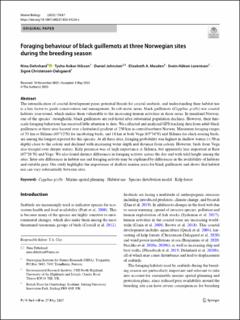| dc.contributor.author | Dehnhard, Nina | |
| dc.contributor.author | Anker-Nilssen, Tycho | |
| dc.contributor.author | Johnston, Daniel | |
| dc.contributor.author | Masden, Elizabeth A. | |
| dc.contributor.author | Lorentsen, Svein-Håkon | |
| dc.contributor.author | Christensen-Dalsgaard, Signe | |
| dc.coverage.spatial | Norway | en_US |
| dc.date.accessioned | 2023-06-05T13:04:37Z | |
| dc.date.available | 2023-06-05T13:04:37Z | |
| dc.date.created | 2023-05-26T15:32:25Z | |
| dc.date.issued | 2023 | |
| dc.identifier.issn | 0025-3162 | |
| dc.identifier.uri | https://hdl.handle.net/11250/3069964 | |
| dc.description.abstract | The intensifcation of coastal development poses potential threats for coastal seabirds, and understanding their habitat use is a key factor to guide conservation and management. In sub-arctic areas, black guillemots (Cepphus grylle) use coastal habitats year-round, which makes them vulnerable to the increasing human activities in these areas. In mainland Norway, one of the species’ strongholds, black guillemots are red-listed after substantial population declines. However, their fnescale foraging behaviour has received little attention to date. We collected and analysed GPS tracking data from adult black guillemots at three sites located over a latitudinal gradient of 250 km in central/northern Norway. Maximum foraging ranges of 33 km at Sklinna (65°12′N) for incubating birds, and 18 km at both Vega (65°34′N) and Sklinna for chick-rearing birds, are among the longest reported for this species. At all three sites, foraging probability was highest in shallow waters (<50 m depth) close to the colony and declined with increasing water depth and distance from colony. However, birds from Vega also foraged over deeper waters. Kelp presence was of high importance at Sklinna, but apparently less important at Røst (67°26’N) and Vega. We also found distinct diferences in foraging activity across the day and with tidal height among the sites. Inter-site diferences in habitat use and foraging activity may be explained by diferences in the availability of habitats and suitable prey. Our study highlights the importance of shallow marine areas for black guillemots and shows that habitat use can vary substantially between sites. Cepphus grylle · Marine spatial planning · Habitat use · Species distribution model · Kelp forest | en_US |
| dc.language.iso | eng | en_US |
| dc.rights | Navngivelse 4.0 Internasjonal | * |
| dc.rights.uri | http://creativecommons.org/licenses/by/4.0/deed.no | * |
| dc.title | Foraging behaviour of black guillemots at three Norwegian sites during the breeding season | en_US |
| dc.title.alternative | Foraging behaviour of black guillemots at three Norwegian sites during the breeding season | en_US |
| dc.type | Peer reviewed | en_US |
| dc.type | Journal article | en_US |
| dc.description.version | publishedVersion | en_US |
| dc.rights.holder | © 2023 The Authors | en_US |
| dc.subject.nsi | VDP::Zoologiske og botaniske fag: 480 | en_US |
| dc.subject.nsi | VDP::Zoology and botany: 480 | en_US |
| dc.source.volume | 170 | en_US |
| dc.source.journal | Marine Biology | en_US |
| dc.identifier.doi | 10.1007/s00227-023-04228-x | |
| dc.identifier.cristin | 2149650 | |
| dc.relation.project | Egen institusjon: Norwegian institute for nature research (NINA) | en_US |
| dc.source.articlenumber | 87 | en_US |
| cristin.ispublished | true | |
| cristin.fulltext | original | |
| cristin.qualitycode | 1 | |

